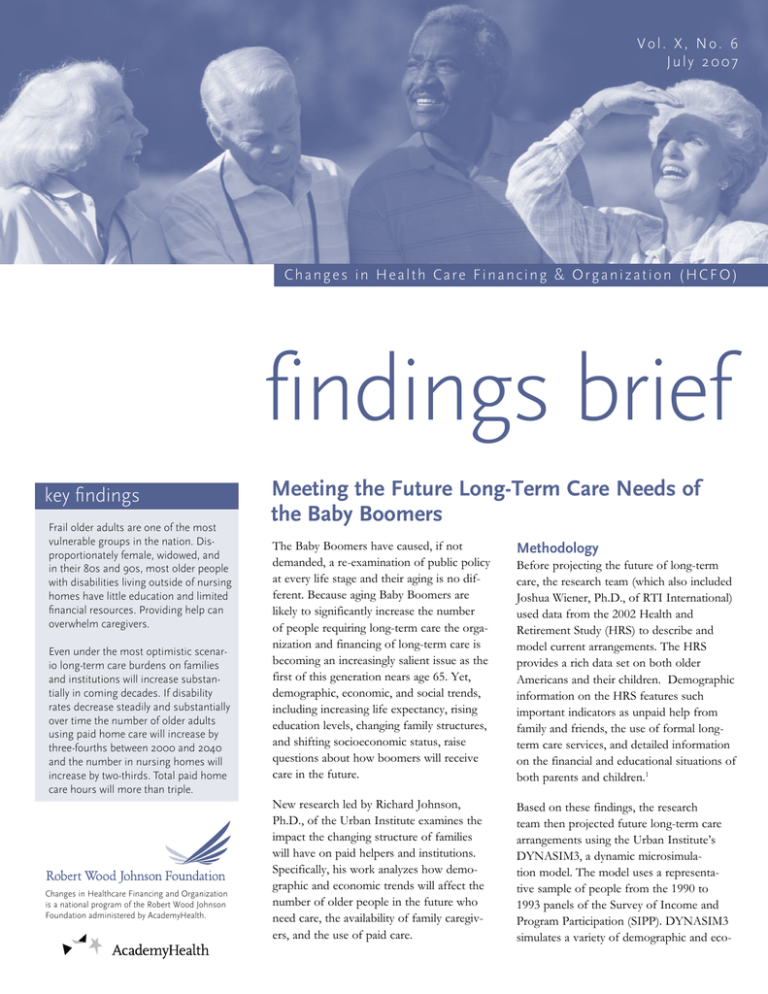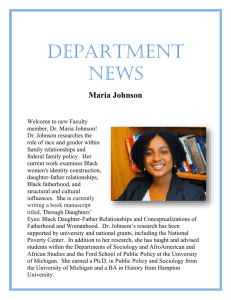V o l . X , N o .... J u l y 2 0 0 7
advertisement

Vol. X, No. 6 July 2007 C h a n g e s i n H e a l t h Ca r e F i n a n c i n g & O r g a n i z a t i o n ( H C F O ) findings brief key findings Frail older adults are one of the most vulnerable groups in the nation. Disproportionately female, widowed, and in their 80s and 90s, most older people with disabilities living outside of nursing homes have little education and limited financial resources. Providing help can overwhelm caregivers. Even under the most optimistic scenario long-term care burdens on families and institutions will increase substantially in coming decades. If disability rates decrease steadily and substantially over time the number of older adults using paid home care will increase by three-fourths between 2000 and 2040 and the number in nursing homes will increase by two-thirds. Total paid home care hours will more than triple. Changes in Healthcare Financing and Organization is a national program of the Robert Wood Johnson Foundation administered by AcademyHealth. Meeting the Future Long-Term Care Needs of the Baby Boomers The Baby Boomers have caused, if not demanded, a re-examination of public policy at every life stage and their aging is no different. Because aging Baby Boomers are likely to significantly increase the number of people requiring long-term care the organization and financing of long-term care is becoming an increasingly salient issue as the first of this generation nears age 65. Yet, demographic, economic, and social trends, including increasing life expectancy, rising education levels, changing family structures, and shifting socioeconomic status, raise questions about how boomers will receive care in the future. Methodology New research led by Richard Johnson, Ph.D., of the Urban Institute examines the impact the changing structure of families will have on paid helpers and institutions. Specifically, his work analyzes how demographic and economic trends will affect the number of older people in the future who need care, the availability of family caregivers, and the use of paid care. Based on these findings, the research team then projected future long-term care arrangements using the Urban Institute’s DYNASIM3, a dynamic microsimulation model. The model uses a representative sample of people from the 1990 to 1993 panels of the Survey of Income and Program Participation (SIPP). DYNASIM3 simulates a variety of demographic and eco- Before projecting the future of long-term care, the research team (which also included Joshua Wiener, Ph.D., of RTI International) used data from the 2002 Health and Retirement Study (HRS) to describe and model current arrangements. The HRS provides a rich data set on both older Americans and their children. Demographic information on the HRS features such important indicators as unpaid help from family and friends, the use of formal longterm care services, and detailed information on the financial and educational situations of both parents and children.1 findings brief — Changes in Health Care Financing & Organization (HCFO) nomic processes, including births, deaths, marriages, divorces, labor force participation, earnings, hours of work and retirement. Additionally, the model simulates Social Security coverage and benefits, employer-sponsored pension participation, benefit payments, and pension assets. It also projects home and financial assets, health assets, living arrangements, and income from other family members. Finally, it calculates Supplemental Security Income (SSI) eligibility, participation and benefits.2 Current Patterns in Long-Term Care An understanding of current long-term care arrangements, health care purchasing, and assisted living and nursing home trends is critical to predicting future needs. Today, gender disparities exist in both the number of frail elderly needing help with the tasks of daily living and the informal caregivers who provide this assistance. According to Johnson “longterm care is a women’s issue.” In describing this gender imbalance, Johnson states, “Nearly two-thirds of older people with severe disabilities are female; women represent twothirds of all unpaid caregivers; and daughters account for 7 out of every 10 adult children who help their frail parents and approximately five of every six who assume primary responsibility for their personal care.”3 The need for long-term care also often carries serious financial consequences. “Longterm care is a leading cause of catastrophic out-of-pocket costs for families and involves substantial government spending through Medicaid and Medicare.” 4 Only a small segment of the population is able to receive paid home care through Medicaid. Most others with disabilities that require care have minimal financial resources and rely on unpaid assistance from family and friends. It is not uncommon for individuals or couples to exhaust their financial resources paying for long-term care before they are eligible for government services. To compound this financial complexity, few people carry longterm care insurance, which typically has high premiums, and even if they do, often this insurance has limited benefits that do not fully cover the cost of care.5 page 2 Figure 1. Frail Adults Ages 65 and Older as a Percentage of the Population Ages 25–64, 2000–2040 12% 10.6% 9.6% 10% 8% 7.5% 6.6% 6.4% 2000 2010 6% 4% 2% 0% 2020 2030 2040 Source: Johnson, R, Toohey, D, and Joshua Wiener. “Meeting the Long-Term Care Needs of the Baby Boomers: How Changing Families Will Affect Paid Helpers and Institutions,” The Retirement Project, Discussion Paper 07-04, The Urban Institute, May 2007. Note: Estimates are based on the intermediate disability growth scenario. The analysis defines frailty as having any ADL or IADL limitations. People are classified as frail if they have limitations with an activity of daily living or instrumental activity of daily living. Although nursing homes and assisted-living offer options for long-term care, many frail elderly adults continue to live in community settings either to maintain independence, comfort, social lives, or because the cost of nursing homes and assisted living is prohibitive. However, paid care in non-institutional settings is rare. Johnson’s work reveals that only 14.3 percent of frail older adults and 36.6 percent of older adults with severe disabilities received paid home care services in 2002.6 The quality of this care varies and Johnson notes that “a growing shortage of paid long-term care workers will likely further threaten service delivery.” 7 Given the number of people caring for their elderly family members in an informal manner, it is important to note that unpaid caregivers often struggle with assisting their family members. Johnson reports that “unpaid caregivers who assume primary responsibility for the personal care of a frail older adult average 201 hours of help per month.” More than half of adult children helping their frail older parents are employed and one in three spouses caring for their partners have health issues of their own.8 The responsibilities of this care, Johnson states, can often overwhelm them. Changes in Family Structure Recent changes in family structure may have significant consequences for the availability of unpaid long-term care. Johnson asserts that declines in birth rates, decreases in family size and increases in divorce rates, childlessness rates, and the share of people who never marry all could potentially limit the availability of unpaid long-term care by family members. Additionally, as women have entered and stayed in the workforce their ability to provide care has been reduced. According to Johnson, “it is unclear whether men will fill the gap.” 9 The researchers hypothesized that families would make long-term care arrangements to maximize benefits and minimize costs. Johnson’s findings support this hypothesis. He found that “as women’s employment prospects improved they were less likely to provide the same number of hours of informal care.” Johnson observed that as adult children’s wages increased, the hours of care they provided to their parents fell while the hours of care from paid providers increased.10 Childless, frail older adults received substantially less care from all sources than adults with children.11 findings brief — Changes in Health Care Financing & Organization (HCFO) Changes in Disability Rates Implications for Policy The research team posits that the future demand for long-term care depends not only on changes in family structure but also on changes in disability rates. Johnson’s research demonstrates that the economic burden of long-term care is likely to increase as the ratio of older people with disabilities to healthy young people grows rapidly. Johnson modeled three distinct scenarios based on low, intermediate, and high disability rates among older adults. The growing demand for cost-effective and cost-efficient long-term care warrants the close attention of policymakers. Johnson points out that “Medicaid policy is biased toward institutionalization and against longterm care. Efforts to level the playing field could result in a much larger increase in paid home care than we projected.”14 Longterm care policy intersects with labor policy and immigration policy. Current shortages of long-term care workers do not bode well for meeting the growing need of homebased paid help. Many long-term care workers are immigrants whose work could be essential to meeting demand. Even in the most optimistic, low-disability scenario, which assumes that disability rates fall by 1 percent per year, the size of the disabled population will grow by more than 50 percent between 2000 and 2040 and the number of disabled older adults for every adult age 25 to 64 will increase. The intermediate-disability scenario, which Johnson refers to as the “best bet,” indicates that disability rates will initially decline between 2000 and 2020 but will then increase as boomers reach 85. The net effect under these assumptions is that the number of paid home care users will more than double between 2000 and 2040, and people will use home care more intensively. As a result, the number of home care hours will more than triple.12 The high-disability scenario assumes that disability rates will continue to rise. If this is the case, then total paid home care hours would nearly quadruple and total unpaid help hours would increase as well.13 Thus, regardless of how disability rates evolve, not only will there be a greater demand for long-term care but also slower growth in the number of people to provide informal and paid care. Johnson states that this change will “undoubtedly increase the economic burden of long-term care on society.” Additionally, Johnson notes that there is a need to pay closer attention to the needs of informal caregivers. Policies that include time and payment mechanisms for respite care are important for supporting these individuals. Increased support for adult day care centers is one option for addressing this need. Johnson states that it is “worth considering incorporating a long-term care benefit into Medicare.” He acknowledges that this would entail further financial burden for an already stretched public program. However, the research findings raise questions about whether the private market will be able to adequately meet peoples’ long-term care needs either financially or in terms of needed services. Johnson cautions that the research presented is based only on projections where long-term care policy stays relatively constant. Whatever the current or future policy of long-term care, it is critical to remember that those who need such care are often a vulnerable and complicated population. Johnson notes that any future policy would, “want to make the administrative process as simple as possible.” This is essential when one considers that “not everyone has family nearby and willing to help.” page 3 Endnotes 1 Johnson, R, et al. “Meeting the Long-Term Care Needs of the Baby Boomers: How Changing Families Will Affect Paid Helpers and Institutions,” The Retirement Project, Discussion Paper 07-04, The Urban Institute, May 2007. 2 Ibid. 3 Johnson, R. and J. Wiener, “A Profile of Frail Older Americans and Their Caregivers,” The Retirement Project, Occasional Paper Number 8, The Urban Institute, February 2006. 4 Ibid. 5 Johnson, R. Presentation at The Urban Institute, Washington D.C., May 2007 6 Johnson, R, et al. “Meeting the Long-Term Care Needs of the Baby Boomers: How Changing Families Will Affect Paid Helpers and Institutions,” The Retirement Project, Discussion Paper 07-04, The Urban Institute, May 2007. 7 Johnson, R. and J. Wiener, “A Profile of Frail Older Americans and Their Caregivers,” The Retirement Project, Occasional Paper Number 8, The Urban Institute, February 2006. 8 Ibid. 9 Johnson, R. and J. Wiener, “A Profile of Frail Older Americans and Their Caregivers,” The Retirement Project, Occasional Paper Number 8, The Urban Institute February, 2006. 10 Johnson, R. “Choosing Between Paid Elder Care and Unpaid Help from Adult Children: The Role of Relative Prices in the Care Decision.” In Caregiving Contexts: Cultural, Familial, and Societal Implications, edited by Maximiliane E. Szinovacz and Adam Davey. New York: Springer Publishing Company, forthcoming. 11 Johnson, R. “In-Home Care For Frail Childless Adults: Getting By With a Little Help from Their Friends?” The Retirement Project, Discussion Paper 06-01, The Urban Institute April 2006. 12 Johnson, R, et al. “Meeting the Long-Term Care Needs of the Baby Boomers: How Changing Families Will Affect Paid Helpers and Institutions,” The Retirement Project, Discussion Paper 07-04, The Urban Institute, May 2007. 13 Ibid. 14 Johnson, R. Presentation at The Urban Institute, Washington, D.C. May 2007.




